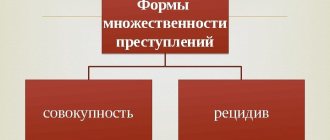The imposition of punishment based on cumulative sentences is related to the time limits for a person to commit a new crime: the rules on sentencing based on cumulative sentences are applied if a new crime was committed after the court announced one conviction against this person (Article 310 of the Code of Criminal Procedure) (regardless of its entry into force ) and until he completes his sentence under such conviction.
If a new crime is committed before the pronouncement of the verdict, then this forms a cumulative crime; If a new crime is committed after the full serving of a sentence under one sentence and before the expiration (removal) of a criminal record, then this in a number of cases can serve as a basis for establishing a recidivism of crimes.
First, the court imposes a new sentence for a newly committed crime. If, after the pronouncement of a guilty verdict against a person, he has committed several crimes, then, having imposed punishment for each crime separately, the court, before imposing punishment for the aggregate of sentences, assigns a punishment for these newly committed crimes for the aggregate of crimes.
Next, the court determines the unserved part of the sentence under the previous court verdict, i.e. establishes what amount (term) of punishment must still be served by the convicted person; at the same time, the size (term) of the unserved part of both the main and additional types of punishment is established.
The next step is to determine the option of imposing the final punishment based on the totality of sentences. The law gives the court the right to either fully or partially add up the punishment for two sentences.
The actual assignment of punishment based on the totality of sentences: to the punishment imposed under the last sentence, in accordance with the addition option chosen by the court, the unserved part of the punishment under the previous sentence is partially or completely added.
Partial addition of punishments
The court increases the punishment imposed for a newly committed crime, adding to it, at its discretion, part of the amount (term) of the unserved punishment, and such an increase occurs in units of calculating the amounts (terms) of types of punishments provided for in Part 1 of Art. 72 of the Criminal Code of the Russian Federation.
In accordance with Part 4 of Art. 70 of the Criminal Code of the Russian Federation, the final punishment for the totality of sentences must be greater than both the punishment imposed for the newly committed crime and the unserved part of the punishment for the previous sentence. This means that if the unserved part of the punishment under a previous sentence is greater than the punishment imposed for a newly committed crime, then the unserved part of the punishment can be added to the punishment imposed for a newly committed crime only with the expectation that the final punishment will exceed that imposed for the newly committed crime. the crime committed and the unserved part of the punishment.
Assignment of punishment. Conditional punishment.
Assignment of punishment for a set of crimes, in case of recidivism, in case of a set of sentences. Conditional punishment.
Chapter 10 is devoted to the imposition of punishment in the Criminal Code of the Russian Federation, in which, from Art. 60 of the Criminal Code of the Russian Federation under Art. 74 of the Criminal Code of the Russian Federation describes the rules for assigning punishment, what mitigating and aggravating circumstances of committing a crime exist, how they are taken into account, how punishment is assigned for recidivism, a set of crimes, a set of sentences, the procedure for determining the terms when adding sentences, assigning a suspended sentence, etc.
Thus, as a general rule, a person guilty of committing a crime is given a fair punishment within the limits of the sanction provided for by the relevant article of the Criminal Code of the Russian Federation. When imposing a punishment, there may be circumstances that can either positively (mitigating) or negatively (aggravate) influence its size for the defendant. Thus, the most common mitigating circumstances include the presence of pregnancy, young children, the commission of a crime due to a combination of difficult circumstances, under duress, provocation by the victim of a crime, surrender (we recommend using only after consultation with a lawyer!!!), provision of medical assistance to the victim . Aggravating circumstances are relapse, grave consequences, commission of a crime against a pregnant woman, with particular cruelty, etc.
Of course, recidivism, a set of crimes, a set of sentences entail more severe punishment. But even here there are certain rules for assigning punishment; if they are applied wisely during the inquiry, investigation, and in court, you can structure your behavior and position in such a way that you can count on a more lenient punishment than may be assigned. Thus, it is especially interesting from the standpoint of protecting Art. 64 of the Criminal Code of the Russian Federation The appointment of a more lenient punishment than provided for this crime, according to which in the presence of exceptional circumstances related to the goals and motives of the crime, the role of the perpetrator, his behavior during or after the commission of the crime, and other circumstances that significantly reduce the degree of public danger of the crime , as well as with the active assistance of a participant in a group crime in solving this crime, the punishment may be assigned below the lower limit provided for by the relevant article of the Special Part of this Code, or the court may impose a more lenient type of punishment than provided for by this article, or not apply an additional type of punishment provided for as mandatory. Both individual mitigating circumstances and a combination of such circumstances may be considered exceptional. Also, in some cases, if, when committing a crime of minor or moderate gravity for the first time, the court, having imposed a punishment in the form of correctional labor, detention in a prison camp or imprisonment for a term of up to eight years, considers it possible to correct the convicted person without actually serving the sentence, may decide to consider the imposed sentence was suspended in accordance with Art. 73 of the Criminal Code of the Russian Federation. It is not always possible to achieve a suspended sentence, but this practice is quite widespread. An experienced lawyer in a criminal case can help not only during the inquiry or investigation, but also when considering the case in court; the position and arguments of the defense attorney can directly influence the court's verdict in the direction of mitigating the punishment. To contact a criminal lawyer, call the phone number listed on the website.
Appointment in case of multiple acts
Taking into account the fact that it is assumed not only the combination of several verdicts, but also acts, the issue of this type of multiplicity of dangerous actions, such as the addition of crimes, should be separately considered. Practice brings the concepts under consideration together, which requires separate coordination of each option.
To connect several crimes in one criminal case, the fact that a person has not been involved as a suspect and the person has committed several acts at once will be required.
This procedure has two stages. The first is the appointment of a coercive measure for each individual crime. This need is due to the fact that various attacks can be committed jointly, up to particularly serious offenses, which makes the list of possible types of restrictions more disparate. Without specifying each individual act, it will be impossible to adjust the overall measure of influence in compliance with all established goals.
The second stage is the addition of the identified coercive means, using one of the possible methods:
- in case of fragmentation of restrictions, the absorption of a less strict measure by a more severe one due to the overall gravity of the offense;
- complete addition in case of possible mutual replacement of similar measures of influence;
- partial addition, in which some sanction remains in one type for a specific offense, and other types are added up, forming a total serving period.
The judge, through personal convictions and independent assessment of possible measures of influence, determines the method of adding restrictive measures.
Just as with the combination of decisions, the legislator determines restrictions in case of plurality. It is impossible to freely aggravate a compulsory remedy for the guilty person or, conversely, soften it. The main condition applies when imposing a sentence of imprisonment. Here the total term cannot exceed twenty-five years, unless we are talking about a life sentence.
In addition to the conditions outlined above, you should also remember the general principles of sentencing. If the act is not completed, then Article 66 of the code is applied, when the definition of accomplices is carried out - Article 33 of the Criminal Code of the Russian Federation, if a minor offender, then the limits of restrictions are taken into account, and so on. The only difference in the totality when compared with cases where individuals are tried for a single assault is the aggravating factor, which allows the punishment to be increased due to the increased danger of the actions of the perpetrator.
The procedure for imposing punishment based on the totality of sentences
The paragraphs of Article 70 of the Criminal Code of the Russian Federation are devoted to such an issue as the imposition of punishment based on the totality of sentences. This part of the legislation applies to cases when a person who has previously been convicted of any crime and has not served his sentence in full commits a new criminal act. In such cases, the order of the totality applies, i.e. addition of previously passed sentences and court decisions in new criminal cases. Punishments can be cumulative in whole or in part, i.e. the new term is added to the unserved portion of the previous sentence.
The following cases are considered as unserved time:
- Prisoner released early under amnesty
- The convict is serving a suspended sentence
- There is a deferment of execution under Article 82 of the Criminal Code of the Russian Federation (for pregnant women and parents of children under 14 years of age)
- The prisoner is in prison
The Criminal Code of the Russian Federation specifies the rules by which sentences are added:
- The entire period previously defined as conditional is added
- Part of the sentence that was forgiven upon parole
- Full duration of deferred sentence
- That part of the prison term that remains with the prisoner on the date of the new sentence
If a sentence was passed for a previous crime, but did not take effect, and the convicted person violated the law again, then he also falls under Article 70 of the Criminal Code of the Russian Federation.
This article of the Criminal Code of the Russian Federation defines the procedure and rules for determining the minimum and maximum possible punishment. Since previous measures of responsibility were not sufficient to influence the convicted person, when reconsidering, judges are guided by the most stringent (maximum) terms that the law provides for crimes committed.
Decisions are not permitted when the final penalty is equal to a more serious crime, i.e. a precedent arises when a less severe sentence is swallowed up by a greater punishment. In practice, judges use a rule according to which they apply:
- The terms are partially added if the committed acts differ significantly in severity, i.e. one term is significantly longer than the other.
- Complete addition when committing several criminal acts of a similar nature.
Goals and types of punishment
In addition to the very essence of the totality and the purpose of the restriction for it, it is necessary to determine what the measures of influence are under criminal law, since several sentences or acts against one person lead not only to addition, but also to aggravation of the chosen measures.
Punishment is restrictive measures imposed on persons guilty of criminal offenses in order to correct the convicted.
The first thing that needs to be established is the goals of influence, since these aspects will guide the court when convicting citizens on several verdicts.
These include the following points:
- correction of guilty citizens;
- preventing the commission of new crimes by criminals, plus unconvicted citizens;
- achieving social justice due to the proportionality of the restrictions and the severity of the act committed.
The appointment of coercive measures when combining decisions and specific acts must also be fully consistent with each of these goals.
You should also separately consider all possible types that are established by the Criminal Code of the Russian Federation and can be used when making a verdict by the court:
- Fine. The amount of this type of penalty cannot be more than five million rubles.
- Depriving a person of the opportunity to engage in a specific type of activity. The period is determined up to five years, if this is the main restriction, and if additional, then up to three years.
- Termination of a title, rank or award. Also permissible when combining sentences.
- Compulsory and corrective labor. The former should be appointed in free time that does not affect work activity, for a period of up to four hundred and eighty hours, and the latter are permissible for serving directly at the place of work for a period of up to two years.
- Restriction of freedom, and for military personnel - restriction on military service. The maximum period is four and two years, respectively.
- Deprivation of liberty. Imprisonment can be imposed either for a specified period or for life. If it is not possible to impose a life sentence, then several sentences do not allow a total prison term of more than thirty years.
It also defines the types of measures that are directly enshrined in the law but are not applied in practice: arrest, forced labor and the death penalty.
The judge must follow a number of principles that allow him to correctly distribute restrictions and replace one option with another in the case where one of the types of aggregate is established. To determine the scheme for prescribing measures of influence, as well as compliance with the limits, the judge can turn to practice, his own beliefs, and case materials.







